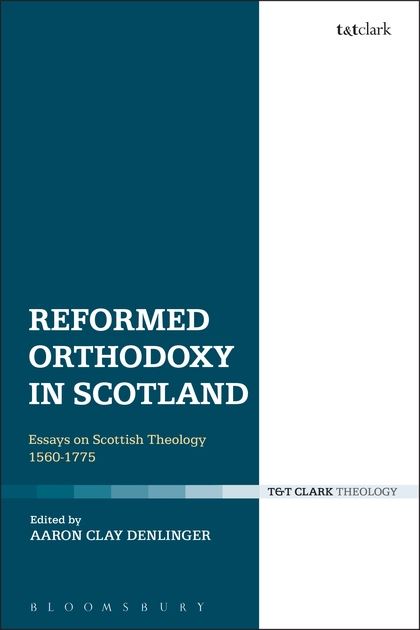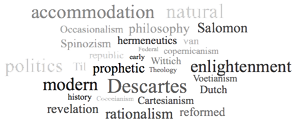Reformed Orthodoxy in Scotland: Essays on Scottish Theology 1560-1775, edited by Aaron Clay Denlinger. London/New York: Bloomsbury T&T Clark, 2015. 304 pages.
 The section on High Orthodoxy is opened by two chapters on the well-known Scottish Scholastic theologian Samuel Rutherford (c. 1600-1661). The first one is written by Simon J.G. Burton (PhD, University of Edinburgh; Assistant Professor and Postdoctoral Fellow in the Faculty of Artes Liberales at the University of Warsaw, Poland) and deals with Rutherford’s moral theology. First, Burton sets forth the historical context in which Rutherford developed his own moral theory, namely the discussions surrounding John Cameron’s intellectualist approach and the more voluntarist adaption of Cameron’s view in one of his students. Then, he describes Rutherford’s view pointing out the impact late-medieval Scholastic discussions (Scotus, Durandus, Bradwardine etc.) had on the development of his rather unique perspective. According to Burton, Rutherford’s moral theology ties in with the “Scotist and voluntarist” stream in Reformed Orthodoxy (Twisse, Voetius etc.). Whoever is interested in the impact of late-medieval thought on Protestant Scholastic moral theory will profit from this fascinating piece of historico-theological scholarship.
The section on High Orthodoxy is opened by two chapters on the well-known Scottish Scholastic theologian Samuel Rutherford (c. 1600-1661). The first one is written by Simon J.G. Burton (PhD, University of Edinburgh; Assistant Professor and Postdoctoral Fellow in the Faculty of Artes Liberales at the University of Warsaw, Poland) and deals with Rutherford’s moral theology. First, Burton sets forth the historical context in which Rutherford developed his own moral theory, namely the discussions surrounding John Cameron’s intellectualist approach and the more voluntarist adaption of Cameron’s view in one of his students. Then, he describes Rutherford’s view pointing out the impact late-medieval Scholastic discussions (Scotus, Durandus, Bradwardine etc.) had on the development of his rather unique perspective. According to Burton, Rutherford’s moral theology ties in with the “Scotist and voluntarist” stream in Reformed Orthodoxy (Twisse, Voetius etc.). Whoever is interested in the impact of late-medieval thought on Protestant Scholastic moral theory will profit from this fascinating piece of historico-theological scholarship.
Chapter eight is the second contribution dealing with Rutherford. Aza Goudriaan (PhD, University of Leiden; Associate Professor of Church History at VU University Amsterdam, the Netherlands) analyses Rutherford’s Metaphysical Investigations (q. 1-7) with a view to ascertaining the Scotsman’s view on possibilities and impossibilities. Similar to Burton, Goudriaan does not content himself with merely describing Rutherford’s position. He also seeks to determine the historical context to the debate, the medieval background, and the reception history of Rutherford’s metaphysical thought. Goudriaan shows that Rutherford follows Bradwardine in arguing that possibility and impossibility are not founded in things themselves but rather in the omnipotence of God. This assertion Rutherford directs specifically against contemporaneous Jesuit theologians who argued for a root possibility / impossibility in the things themselves.
The ninth chapter by Guy M. Richard (PhD, University of Edinburgh) aims at discerning the role of the “Song of Songs” in Scottish Reformed Orthodoxy in comparison with its role in early modern Europe more generally. Having described the pivotal role of this biblical book for the development of ‘Reformed Spirituality’ and its use in the various debates between Protestant groups in England, Richard briefly outlines James Durham’s (1622-1658) approach to the Song of Songs in his commentary entitled Clavis Cantici (posthumously published in 1668). the final and major section of the article consists in a portrayal of the religious struggles in early modern Scotland. In this section, Richard argues that Scottish Puritan divines (like Rutherford and Durham) detected a double threat to the cause of the Reformation in their times. Both Arminianism and Laudian Episcopalianism were perceived as dangerous developments ultimately leading (back) to Roman-Catholicism. In their combat for the heart of the Scottish people, Richard argues, Scottish Puritans deliberately used the graphic allegory of the Song of Songs in order to convey the Protestant understanding of a vital, heartfelt faith. Richard’s contribution provides a good insight into the historical context of Scottish Puritanism and its struggle to safeguard the reformation. The overall argument concerning the role of Durham’s Clavis Cantici, however, could have been (significantly) improved by showing from the text of the Clavis itself, that this commentary was in fact intended to uphold the Reformation against its various enemies.
In Chapter ten Albert Gootjes (PhD, Calvin Theological Seminary), sets out to demonstrate that the Scottish theologian John Cameron (c. 1579–1625) exerted a formative influence on French Protestant theology in the seventeenth century, particularly with respect to his view on the role of the intellect in conversion. Cameron’s view implies that in conversion God does not act directly on the human will (the traditional Reformed view), but rather mediately through the (renewed) intellect. This intellectualist approach to conversion proved to be very influential as is evident from the “Pajonist controversy” in the 1660s and 1670s, in which Cameron was regularly cited as a first rank authority on the matter. While this is an interesting piece on French Protestantism, one wonders if it really fits in this volume dedicated to Scottish Reformed Orthodoxy. To be sure, Cameron was a Scotsman by origin and he received his initial training at the University of Glasgow. But these facts in themselves do not justify the bold claim that “[f]or the historian of early modern Reformed theology in France […] all roads lead to Scotland.” (190) Could it not be, that Cameron developed his influential and controversial views first during the time he studied at Geneva and Heidelberg (1604-08)?
The final essay pertaining to High Orthodoxy consists in a comparison of the doctrine of justification in John Calvin and John Brown of Wamphray (c. 1610-1679) conducted by Joel R. Beeke (PhD, Westminster Theological Seminary; President and Professor of Systematic Theology and Homiletics at Puritan Reformed Theological Seminary, Grand Rapids, MI, USA). Beeke begins with an outline of Calvin’s view by means of ten principles drawn mainly from his institutes. In a second step, these very same principles are employed in order to ascertain the extent of agreement between Calvin and Brown. In his conclusion, Beeke notes that “there is a remarkable continuity of message between the two men” (209) despite the significant difference with respect to their historical context and theological method. No doubt, this essay adds grist to the mill of those who follow the ‘new school approach’ arguing for a substantial continuity between Calvin and the ‘Calvinists’. Yet, critical questions can and must be raised. Does not the choice of media comparationis (i.e. the ten principles taken from Calvin) to some extent predetermine the result of the comparison? How does Beeke avoid reading Brown through the lens of Calvin? Moreover, one wonders, why there is no interaction with Hans Emil Weber’s famous and still quite influential thesis according to which Orthodoxy’s emphasis on the forensic nature of justification is fundamentally at odds with the organic understanding in the magisterial Reformers. In a sense, this is illustrative of a weakness in some of the more recent contributions from the ‘new school’ approach to Reformed Orthodoxy. Some scholars all too easily dismiss the considerable body of literature adhering to the ‘old school’ perspective (like Weber’s three volume work Reformation, Orthodoxie und Rationalismus, 1937-1951) without careful interaction with its arguments. This is, in my opinion, much to the detriment of ‘new school’ scholarship.
[This is the second part of a three-part series. Next week I will post the final part of this review dealing with section three on Late Orthodoxy. This final part will also include my overall assessment of the book.]

2 Responses to Book Review: Reformed Orthodoxy in Scotland (Part 2)